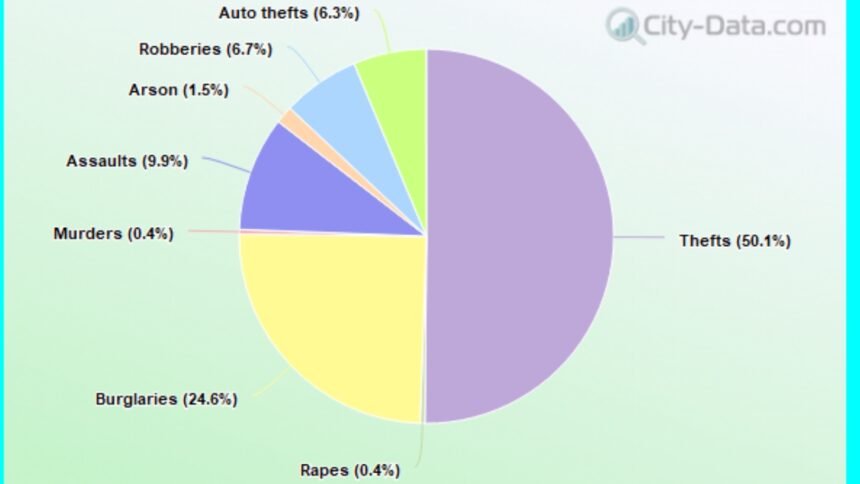Baton Rouge, Louisiana, a city known for its colorful lifestyle and rich history, has also garnered attention for its fluctuating crime rate. The crime rate in Baton Rouge, Louisiana, has been a topic of ongoing concern for residents, policymakers, and law enforcement. While the city is widely known for its arts, music, and Southern hospitality, it also faces challenges in ensuring the protection and safety of its citizens. In recent years, Baton Rouge has seen an uptick in violent crime, which has sparked debates on the causes, impacts, and potential solutions to the problem. Understanding the crime rate in Baton Rouge requires a closer look at the city’s demographics, law enforcement efforts, and community-based projects aimed at tackling the issue. This article will explore the current state of crime in Baton Rouge, examine the factors contributing to it, and discuss potential solutions for decreasing crime and improving safety.
The Current Crime Rate in Baton Rouge, Louisiana
The crime rate in Baton Rouge has been a significant issue, especially in recent years. According to the latest crime data, the city consistently ranks among the highest in Louisiana for violent crime. As of the most recent reports, Baton Rouge reports a higher-than-average rate of homicides, armed robberies, and aggravated assaults. In fact, the violent crime rate in Baton Rouge is significantly above the national average, which has prompted local officials to take action. The city has witnessed a surge in homicides, with 2020 marking one of the deadliest years in recent history. The increase in violent crime has not only affected the city’s reputation but has also had a deep impact on its residents, leading to heightened anxiety and fear within the community.
While violent crime is a primary concern, property crimes such as burglary and larceny-theft have also been prevalent in Baton Rouge. These crimes, although not as deadly, contribute significantly to the overall crime rate and affect the everyday lives of residents. A large portion of the population has expressed concerns over the safety of their neighborhoods and personal property.
Contributing Factors to the Crime Rate
The question of why the crime rate in Baton Rouge is so high is complex and multifaceted. Several factors contribute to the city’s struggle with crime, many of which are deeply intertwined with socioeconomic issues. One of the main contributors is poverty. Baton Rouge, like many urban centers, faces significant economic disparity. According to census data, a substantial portion of Baton Rouge’s population lives below the poverty line. The lack of access to quality education, job opportunities, and basic services can lead individuals to resort to crime as a means of survival or financial gain.
Another factor is the city’s proximity to major highways and trade routes, which has made it a hotspot for drug trafficking. Baton Rouge has seen an increase in drug-related crimes, particularly those involving narcotics like heroin and methamphetamine. The availability of drugs has contributed to higher rates of addiction, which in turn has fueled violent crime and property thefts. Gangs and organized crime groups also play a role in exacerbating the violence, as turf wars and competition for control of the drug trade often lead to deadly confrontations.
In addition to economic challenges, Baton Rouge also faces a strained relationship between law enforcement and certain communities. Trust issues between the police and minority populations, particularly in low-income areas, have been a source of tension. Instances of police brutality and racial profiling have eroded public trust, making it more difficult for law enforcement to effectively address crime. These challenges are compounded by the lack of community resources, such as mental health services, that could provide alternatives to the criminal justice system for individuals in need.
Law Enforcement and Community Efforts to Combat Crime
In response to the growing crime rate, Baton Rouge’s law enforcement agencies, alongside community organizations, have ramped up efforts to combat crime and improve safety. The Baton Rouge Police Department (BRPD) has implemented various crime prevention strategies, including increased patrols in high-crime areas, the use of surveillance technology, and a greater emphasis on community policing. However, these efforts have not always been met with success, as the city continues to experience high levels of violent crime.
Community-based initiatives have also been at the forefront of addressing the root causes of crime in Baton Rouge. Programs aimed at providing educational opportunities, job training, and mentorship have been instrumental in steering young people away from criminal behavior. One notable program is the “Second Chance Program,” which provides job placement services and counseling to individuals with criminal records, helping them reintegrate into society. Local organizations like the Baton Rouge Area Foundation (BRAF) have also worked to reduce poverty and improve access to healthcare, housing, and education in underserved communities.
Additionally, Baton Rouge has seen a rise in grassroots movements led by citizens who are working together to take back their neighborhoods. Neighborhood watch programs, community cleanups, and local events aimed at building community cohesion are helping foster a sense of ownership and pride in the city’s residents, encouraging them to be more involved in reducing crime and improving the quality of life.
Expert Opinions on Solutions to Reduce Crime
Dr. Jonathan Green, a criminologist at Louisiana State University, suggests that addressing the crime rate in Baton Rouge requires a multi-pronged approach. He emphasizes that reducing poverty and increasing access to quality education and job opportunities are key to addressing the root causes of crime.
“We can’t just arrest our way out of this problem,” Dr. Green says. “We need to create opportunities for people to improve their lives so that crime is not their only option.”
Green’s statement aligns with a broader perspective in criminology, which suggests that social and economic inequalities are major contributors to criminal behavior.
Furthermore, experts agree that increasing trust between law enforcement and communities is crucial. Collaborative efforts between the police and local residents can help bridge the gap, ensuring that residents feel comfortable reporting crimes and working alongside law enforcement. This collaboration can also lead to more effective policing strategies that are tailored to the needs of each neighborhood.
Potential Solutions and the Path Forward
While the crime rate in Baton Rouge remains a significant concern, there are several paths forward that could lead to positive change. First and foremost, tackling the root causes of crime, such as poverty, lack of education, and drug addiction, is critical. The city must continue to invest in programs that provide young people with viable alternatives to criminal behavior, such as after-school programs, job training, and apprenticeships.
Moreover, improving the relationship between law enforcement and the community is essential. This could be achieved through better police training, community policing initiatives, and increased transparency in the criminal justice system. Strengthening the community’s involvement in crime prevention through programs like neighborhood watch groups and local partnerships with police could also help to reduce crime.
In addition, the city must address its opioid crisis and drug-related violence through stronger law enforcement, addiction treatment programs, and community education on the dangers of drug abuse.
Conclusion: Moving Toward a Safer Baton Rouge
The crime rate in Baton Rouge, Louisiana, is a complex issue that requires a comprehensive approach to tackle effectively. While law enforcement and community organizations are taking steps to address the issue, long-term solutions will depend on reducing poverty, improving education, and fostering better relations between the police and the communities they serve. By addressing both the symptoms and the root causes of crime, Baton Rouge has the potential to become a safer city for all of its residents. It will require a collective effort from the community, law enforcement, and policymakers, but with continued commitment and collaboration, Baton Rouge can overcome these challenges and work toward a brighter, safer future.






